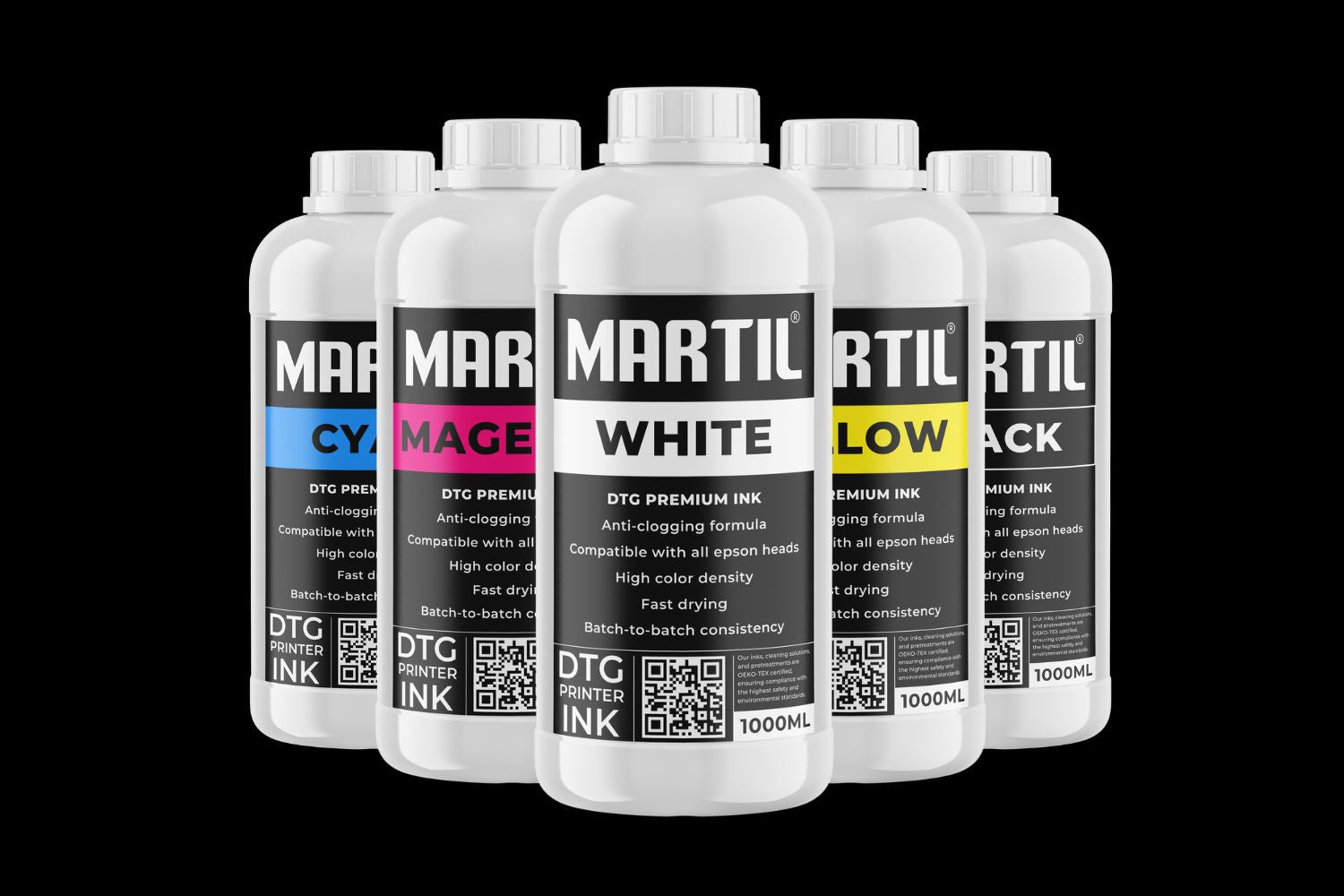Introduction
DTG (Direct To Garment) printing has revolutionized the textile industry by enabling high-resolution prints, rich in detail and vibrant colors. However, the quality of the final result does not depend solely on the printer or the textile used: the choice of DTG inks is a determining factor . An unsuitable ink can result in a dull finish, poor adhesion to the textile and rapid degradation after washing.
The DTG ink market is vast, and not all are created equal. Some offer excellent durability but require specific pretreatment, while others guarantee vibrant colors but are more susceptible to wear. It's therefore crucial to select the right ink based on your printer type, the fabric being used, and the desired quality.
Whether you're a professional looking to maximize your production efficiency or a beginner looking for professional results, this guide will help you choose the best DTG inks for durable and vibrant prints. We'll cover essential selection criteria, the differences between ink types, their compatibility with various textiles, and best practices for maximizing their durability.
👉 Discover our DTG ink compatible with all Epson heads and print with vibrant colors!
The essential criteria for choosing a quality DTG ink
Ink composition and its impact on printing
DTG inks are typically water-based and contain pigments specifically designed to adhere to textile fibers. A good ink should strike a balance between fluidity and density to ensure even deposition and prevent printhead clogging.
👉 Choose fluid and high-performance inks with our DTG ink compatible with all Epson heads
Compatibility with your DTG printer
Each DTG printer is optimized to work with a specific range of inks. Using the wrong ink can lead to compatibility issues, poor adhesion, or clogging of the print heads.
OEKO-TEX certification and ecological standards
Some DTG inks are OEKO-TEX certified, guaranteeing that they do not contain harmful substances. This is essential if you want to offer environmentally friendly clothing.
👉 Secure your prints with our OEKO-TEX certified DTG ink .
DTG inks: what are the differences between white ink and color ink?
Why is white ink essential in DTG?
White ink is the basis for all printing on dark textiles. Without it, colors lose their vibrancy and become translucent. However, it is denser than other colors and requires proper pretreatment to prevent flaking after washing.
👉 Boost the contrast of your prints with our high opacity white DTG ink .
How to ensure vibrant colors on all types of textiles?
DTG color ink must provide optimal saturation while maintaining excellent wash resistance. A good color profile and pigmented inks ensure faithful rendering of original designs.
The importance of pretreatment to optimize ink adhesion
Pretreatment is essential, especially for white ink. It prevents the ink from penetrating too deeply into the fibers, thus ensuring better opacity and hold.
👉 Optimize your prints with our DTG pre-processing solution .
Compatibility of DTG inks with different textiles
DTG inks on cotton: the ideal textile for successful printing
Cotton is the most commonly used fabric for DTG printing because it absorbs ink well and provides a crisp, clear result. However, it's important to use specific inks to ensure optimal adhesion.
👉 Improve your cotton prints with our high quality DTG ink .
Can you print DTG on polyester and synthetic textiles?
Unlike cotton, polyester slightly repels water-based inks. We recommend printing on fabrics made of at least 80% cotton.
DTG inks on mixed textiles: advantages and precautions
Cotton-polyester blends offer a good balance between comfort and durability, but require specific settings to ensure a consistent and durable print. Ideally, 80% cotton / 20% polyester.
Maximize the durability and profitability of your DTG prints
Best practices for extending the life of DTG inks
Improper storage can affect the quality of your inks. Store them in a cool, dry place away from light and use them before the expiration date to avoid any flow issues.
👉 Preserve the quality of your prints with our high stability DTG ink .
Regular maintenance of your printer to avoid clogs
DTG inks can dry out in the printheads if not used regularly. Daily maintenance with specific cleaning solutions can prevent these problems and extend the life of your equipment.
👉 Discover the Martil cleaning solution
Optimizing ink consumption for profitable production
Using suitable ICC profiles and adjusting ink density to suit the printed textile helps reduce waste and improve the profitability of your production.
Conclusion
Choosing the right DTG inks is a critical factor in ensuring long-lasting, vibrant prints. A good ink should offer excellent adhesion, optimal color saturation, and good wash resistance.
- Make sure you choose inks that are compatible with your printer to avoid any technical problems.
- Adapt your inks to the textiles used to ensure better adhesion and optimal rendering.
- Choose certified and environmentally friendly inks to ensure safe and reliable printing.
- Optimize your consumption and maintain your equipment for profitable and uninterrupted production.
By applying these tips and selecting the right inks, you will be able to offer high-quality products and maximize the profitability of your DTG printing business .
👉 Discover our DTG ink and optimize the quality of your prints now!




Leave a comment
This site is protected by hCaptcha and the hCaptcha Privacy Policy and Terms of Service apply.